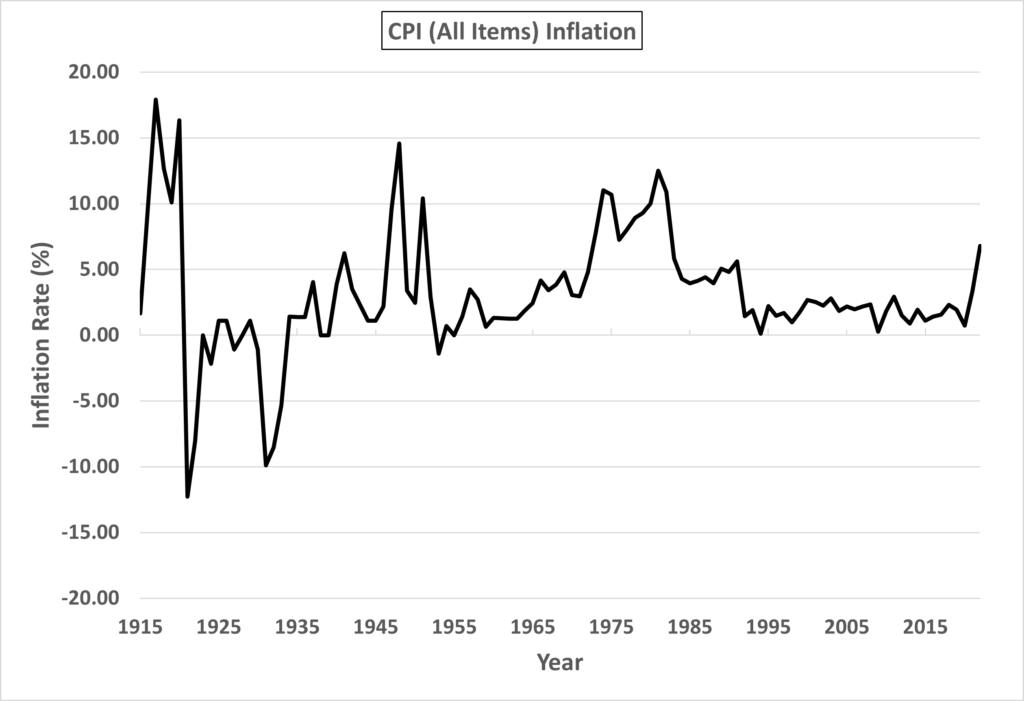
Introduction
Dividends are magical for many investors because they promote patience and consistency in following their investment plan. People who are wired differently than dividend growth investors don’t understand this point – and the purpose of this article certainly isn’t to convince them. In this post, I share my thoughts on how I, as a committed dividend growth investor, plan to navigate what appears to be a turbulent decade ahead for investors. Grab a coffee and let’s get started!.
Dividend growth investors know that high-quality companies will generally continue to pay and grow their dividends through both good and bad times. A company that consistently increases their dividends will eventually be rewarded with a higher stock price. When investors switch their focus from volatile stock prices to a steadily growing income stream, it becomes much easier to follow their investment plan. And consistently following a reasonable investment plan is what leads an investor to successfully reach their goals!
The dividends that investors love so much are not conjured up by a witch, however, they are simply paid out of a company’s earnings. And high-quality companies go one step further – they increase their dividend payments each year in line with their earnings growth. Investors need to be aware of the importance that a company’s dividend growth keep pace with inflation. This will be a central theme of this post.
There is a misconception by some in the investment community that passive investing is the only way to go and that dividend growth investing is not a valid strategy. This is surprising because Ned Davis and Hartford Funds have shown that dividend initiators and growers produce strong investment returns.
Many long term investors, including myself, are wary of the financial services industry after paying excessive management fees for mutual funds during the early days of our investment journey. We have taken control of our finances and don’t plan to ever switch back to a passive investing approach. The financial services industry has always employed marketing gimmicks to increase their profits at the expense of ordinary investors. This is unlikely to change during my lifetime.
In this post, I look at historical investment returns of the S&P/TSX index over the past 50 years and talk about the increased relevance of a dividend growth approach during inflationary times.
S&P/TSX Historical Investment Returns
The total return of the S&P/TSX index over the past 50 years has averaged 9.0%, according to data posted on TaxTips.ca. The Canadian Consumer Price Index has averaged 4.0% over the same timeframe. Thus, the total return of the S&P/TSX index has been 5.0% in real terms, approximately 60% (3% or 300 basis points) of this total is due to dividends. This implies that real annual capital gains average 2%.
In Canada, investors pay taxes on nominal capital gains. Roughly one-third of the nominal gain, 2%/(4% +2%) is real, while the remaining two-thirds is an inflationary gain. Investors need to know that taxing an inflationary gain amounts to a capital tax.
The Government of Canada has set the capital gains inclusion rate to 50% to partially compensate for the fact that roughly two-thirds of the average capital gain is due to inflation. The capital gains inclusion rate is still higher than it should be. There is no justification for the Government of Canada to raise it further. This would amount to charging a higher capital tax on investors, which is counterproductive to growing the Canadian economy.
Getting back to the implications of the capital gains tax, investors should always be mentally aware that they are accruing a future capital gains tax liability as their investments increase in value. Moreover, their investment holdings will not maintain their purchasing power if they don’t appreciate by at least the inflation rate x (1 + personal marginal tax rate on capital gains) on average.
I think it is fair to say that investors should consider dividend stocks that are not growing their dividend significantly, say at or above the average inflation rate plus their marginal tax rate on capital gains, as a pseudo fixed income holding. In some cases, these companies offer more risk and potentially much less reward than a safer fixed income product. Caveat emptor!!!
Historical Canadian Inflation Data
Below is a chart of CPI inflation back to 1915. The 1990 to 2020 period can be characterized as a very abnormal time for investors. The inflation rate was maintained in a tight range of 0-3% for more than a quarter of a century. This long period of abnormally low inflation was due to a globalization trend that started at the end of the Cold War in 1990, which provided a lid on the cost of many goods and services.

Inflation has traditionally been much more variable than what we observed during this period of increasing economic globalization. For example, look at the widely varying inflation rates in Canada between 1915 and 1990. There were three periods where inflation rose above 10% and two deflationary periods – the flu pandemic of 1918 and the Great Depression. Investors would be wise to expect that the inflation rate will generally be higher and more variable in the coming years.
Lessons Learned from the Pandemic
In 2020, the COVID-19 pandemic started an abrupt global economic contraction. The production and movement of goods and services was hampered due to government shutdowns. This created supply chain interruptions that extended the economic slowdown. Governments and companies around the world learned that they had made grave errors by completely entrusting foreign entities to deliver critical goods and services. In response, Governments and companies will be pressured to bring the production of economically important goods and services back to home soil, even though this will increase inflationary pressures.
The pandemic also exacerbated geopolitical tensions that had been rising over the previous decade. The Western World is rapidly losing trust in authoritarian regimes as they begin to flex their might. The reduced defense spending by Western World countries since 1990, the so-called “peace dividend,” has contributed to the resurgence of these authoritarian regimes. It is inevitable that the Western World will dramatically increase defense spending over the coming decade, which will also prove to be inflationary.
Investors should anticipate a deglobalization counterphase to undo some of the economic fragility put into the economy as a result of the previous globalization trend. Periods of high inflation, for the abovementioned reasons, will likely be interspersed with deflationary periods due to Central Bank efforts to control inflation. Alternatively, it is possible that certain sectors of the economy may experience strong inflationary pressures due to shortages in conventional energy, materials needed to produce “cleaner” energy technologies and food. At the same time, other sectors (housing, for example) may experience deflationary pressures. The net effect over the decade may be a low growth (stagnating) economy operating in inflationary times.
How I Plan to Navigate the Current Investing Environment
Given the economic backdrop outlined above, I still believe that investors should continue to carefully select and build their portfolio holdings, while only making changes when an investment no longer meets their original investment thesis. High portfolio turnover is one of the easiest ways to reduce your investment returns. That being said, investors need to carefully monitor their holdings and make small incremental changes as the investing environment and their investment objectives change.
I am now mentally prepared for inflation to average 4% over the next decade. Moderate inflation is the least painful way to address the massive global debt problem so that is my assumption going forward. Of course, I will adjust my thinking if this assumption proves to be wrong.
I plan to take three concrete steps over the next few months to prepare my portfolio for the upcoming decade.
The first step is that I will carefully review my stock holdings and identify any stocks that are not growing their revenue and earnings by at least 6% (expected inflation rate plus allowance for capital gains taxes) going forward. It is fairly obvious that owning a bunch of high dividend-paying, lower growth stocks that are slowly eroding your capital in real terms is not a great investment strategy. On the other hand, some of these stocks do provide downside protection during a recession if their dividends are sustainable and their valuations are reasonable.
I will make conscious decisions on whether to hold, reduce or sell my lower-growth stock positions. For tax efficiency purposes, I will begin to transition any lower-growth (higher-dividend) stocks held in a regular account that are keepers to my RRSP or TFSA account. Of course, capital gains tax considerations will be kept in mind.
Secondly, I will use any significant stock market pullback to invest in high-quality, dividend growth companies on my watchlist. These include many companies I already own. As discussed in my last post, Canadian National Railway, Microsoft and Texas Instruments are three companies that I would like to own going forward. I will make these stock purchases when a reasonable factor of safety is present.
Lastly, I will continue to carefully manage portfolio risk, recognizing that significant geopolitical factors are in play beyond regular market factors. I will entertain selling any stock that reaches an unreasonable valuation based on DCF or similar calculation. This approach was clearly articulated in Vitaliy Katsenelson’s excellent book entitled “Active Value Investing: Making Money in Range-Bound Markets.”
Some stock markets may be reasonably priced based on forward P/E multiples (S&P/TSX, for example), but cyclically-averaged P/E (CAPE) ratios of the North American markets are still high. My expectation is that investors will rediscover the relevance of earnings over a complete business cycle if we go into recession.
Final Thoughts
The days of low interest rates are over. This is a major change to the global investing environment going forward. The globalization trend that has been prevalent since 1990 supported a low interest rate policy, which favored growth stocks. Lessons learned during the pandemic have accelerated a deglobalization counterphase that will also last many years. Investors need to be aware of these changes and their impact on investments going forward.
Higher interest rates provide a headwind to both stock and bond prices. Lower growth stocks with significant debt that do not have pricing power will not do well. On the other hand, high-quality stocks with strong moats will be able to raise their prices and grow their earnings. High interest rates act as an inhibitor to economic growth and drive the P/E ratios of all companies downward. History has shown that this eventually provides excellent opportunities for patient investors to acquire positions in great companies at bargain prices.
Patience is a key characteristic of great investors. The market is always trying to trick the unsuspecting investor to buy and sell stocks at inopportune times. Wise investors hold some cash when market odds are unfavorable so that they can later buy when a panic selling opportunity takes place. In the meantime, these investors are content to watch their dividend income continue to grow, build up their cash reserves and wait for their favorite stocks to reach sensible buying prices.
I look forward to exchanging views with other dividend growth investors.

